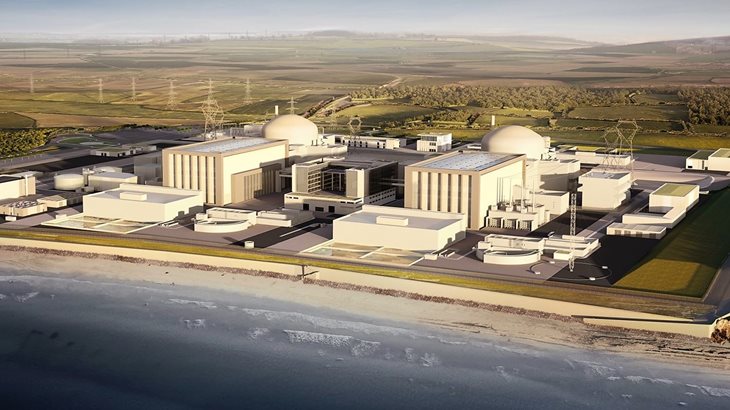Regulator approves change to dry storage at HPC
The UK's Environment Agency has agreed to changes to the environmental permit for the Hinkley Point C nuclear power plant under construction in Somerset, England, allowing used nuclear fuel from the plant to be stored in a dry storage facility rather than a wet facility, as originally planned.

A rendering of the Hinkley Point C plant (Image: EDF Energy)
NNB GenCo (HPC) Ltd was originally issued a radioactive substances environmental permit for the receipt and disposal of radioactive waste at Hinkley Point C in March 2013. In the original design, used nuclear fuel was to be stored on-site in wet storage - a method of submerging and storing in water. The fuel will be stored on-site before being sent to a Geological Disposal Facility (GDF).
However, the company decided that dry storage technology would be used at HPC, which will see used nuclear fuel stored in sealed containers within a facility before it is sent to the GDF.
In June, NNB GenCo (HPC) Ltd applied to the Environment Agency to change its existing radioactive substances environmental permit for HPC, calling for specific conditions related to the previous wet storage technology that are no longer relevant to be removed or amended.
The radioactive substances environmental permit covers the associated discharges, not the storage of waste. However, a change to the permit was required to remove or amend specific conditions related to the previous wet storage technology that are no longer relevant.
Following a four-week public consultation over the proposed change, the Environment Agency agreed to amend the permit and issued the permit variation on 6 October. More than 40 organisations and members of the public responded to the consultation.
"We agree with the applicant's demonstration that the proposed change to spent nuclear fuel storage represents Best Available Technique (BAT) for Hinkley Point C," a spokesperson for the Environment Agency said. "We are satisfied that the change will not lead to an increase in radioactive discharges and will not cause adverse radiological impact on people and the environment.
"The changes will not impact our ability to effectively regulate the site and activities. We will continue to assess spent fuel storage and its impact at Hinkley Point C to ensure that discharges are minimised and that BAT is applied."
Separately, NNB GenCo (HPC) Ltd will be applying to the Secretary of State for the necessary changes to its Development Consent Order for Hinkley Point C later this year.
Construction of Hinkley Point C - composed of two EPR reactors of 1630 MWe each - began in December 2018. The start of electricity generation from unit 1 is expected in June 2026, with unit 2 following in 2027.
NNB GenCo (HPC) Ltd estimates that some 7346 used fuel assemblies will be generated from HPC during its projected 60-year lifespan.
Researched and written by World Nuclear News
- China Institute of Atomic Energy
- Nuclear Power Institute of China
- Southwestern Institute of Physics
- China Nuclear Power Operation Technology Corporation, Ltd.
- China Nuclear Power Engineering Co., Ltd.
- China Institute for Radiation Protection
- Beijing Research Institute of Uranium Geology (BRIUG)
- China Institute of Nuclear Industry Strategy (CINIS)
- China Nuclear Mining Science and Technology Corporation


